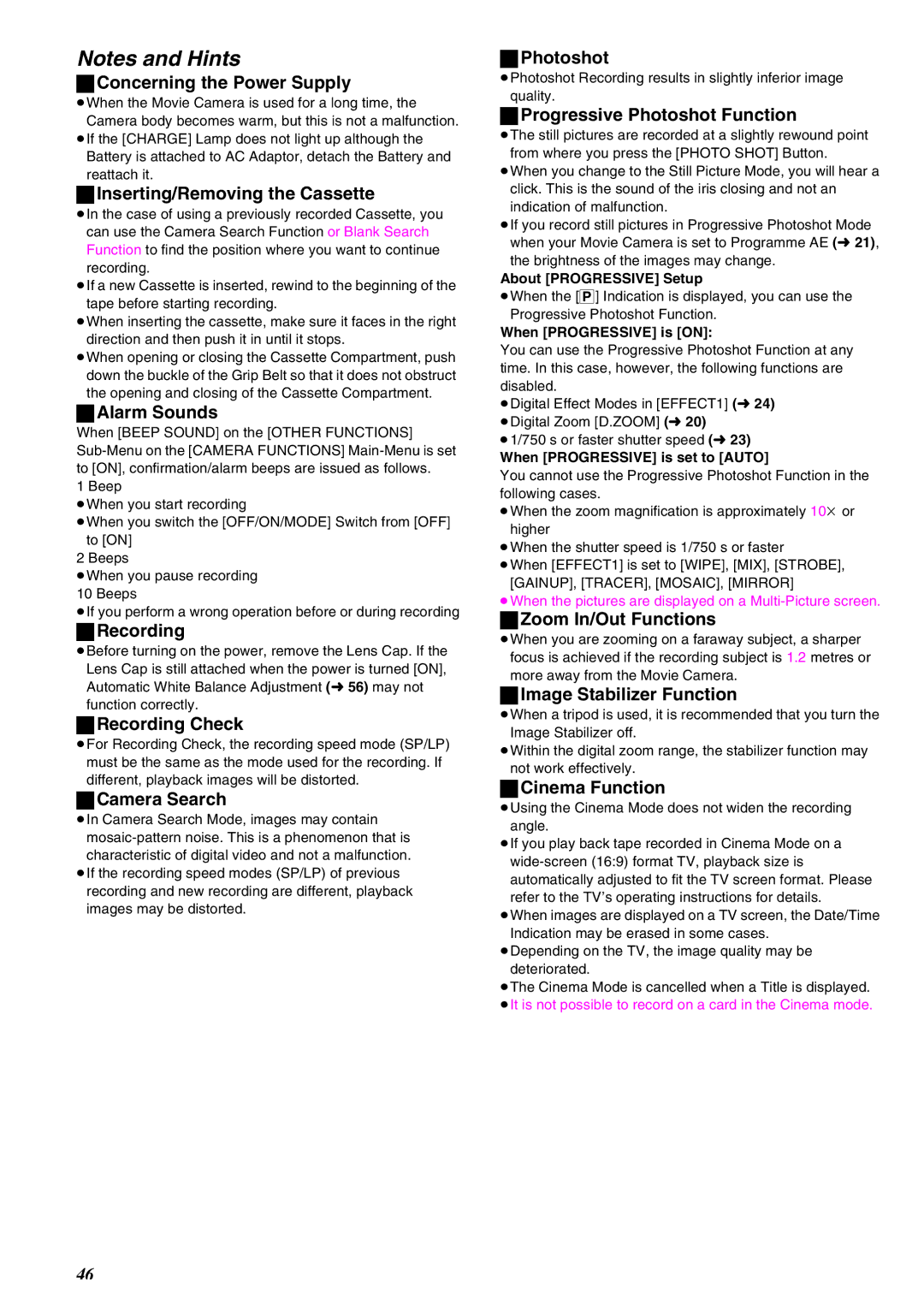Notes and Hints
ªConcerning the Power Supply
≥When the Movie Camera is used for a long time, the Camera body becomes warm, but this is not a malfunction.
≥If the [CHARGE] Lamp does not light up although the Battery is attached to AC Adaptor, detach the Battery and reattach it.
ªInserting/Removing the Cassette
≥In the case of using a previously recorded Cassette, you can use the Camera Search Function or Blank Search Function to find the position where you want to continue recording.
≥If a new Cassette is inserted, rewind to the beginning of the
tape before starting recording.
≥When inserting the cassette, make sure it faces in the right direction and then push it in until it stops.
≥When opening or closing the Cassette Compartment, push down the buckle of the Grip Belt so that it does not obstruct the opening and closing of the Cassette Compartment.
ªAlarm Sounds
When [BEEP SOUND] on the [OTHER FUNCTIONS]
1 Beep
≥When you start recording
≥When you switch the [OFF/ON/MODE] Switch from [OFF] to [ON]
2 Beeps
≥When you pause recording 10 Beeps
≥If you perform a wrong operation before or during recording
ªRecording
≥Before turning on the power, remove the Lens Cap. If the Lens Cap is still attached when the power is turned [ON], Automatic White Balance Adjustment (l56) may not function correctly.
ªRecording Check
≥For Recording Check, the recording speed mode (SP/LP) must be the same as the mode used for the recording. If different, playback images will be distorted.
ªCamera Search
≥In Camera Search Mode, images may contain
≥If the recording speed modes (SP/LP) of previous recording and new recording are different, playback images may be distorted.
ªPhotoshot
≥Photoshot Recording results in slightly inferior image quality.
ªProgressive Photoshot Function
≥The still pictures are recorded at a slightly rewound point from where you press the [PHOTO SHOT] Button.
≥When you change to the Still Picture Mode, you will hear a click. This is the sound of the iris closing and not an indication of malfunction.
≥If you record still pictures in Progressive Photoshot Mode when your Movie Camera is set to Programme AE (l21),
the brightness of the images may change.
About [PROGRESSIVE] Setup
≥When the [æ] Indication is displayed, you can use the Progressive Photoshot Function.
When [PROGRESSIVE] is [ON]:
You can use the Progressive Photoshot Function at any time. In this case, however, the following functions are disabled.
≥Digital Effect Modes in [EFFECT1] (l24) ≥Digital Zoom [D.ZOOM] (l20)
≥1/750 s or faster shutter speed (l23)
When [PROGRESSIVE] is set to [AUTO]
You cannot use the Progressive Photoshot Function in the following cases.
≥When the zoom magnification is approximately 10k or higher
≥When the shutter speed is 1/750 s or faster
≥When [EFFECT1] is set to [WIPE], [MIX], [STROBE], [GAINUP], [TRACER], [MOSAIC], [MIRROR]
≥When the pictures are displayed on a
ªZoom In/Out Functions
≥When you are zooming on a faraway subject, a sharper focus is achieved if the recording subject is 1.2 metres or more away from the Movie Camera.
ªImage Stabilizer Function
≥When a tripod is used, it is recommended that you turn the Image Stabilizer off.
≥Within the digital zoom range, the stabilizer function may not work effectively.
ªCinema Function
≥Using the Cinema Mode does not widen the recording angle.
≥If you play back tape recorded in Cinema Mode on a
≥When images are displayed on a TV screen, the Date/Time Indication may be erased in some cases.
≥Depending on the TV, the image quality may be deteriorated.
≥The Cinema Mode is cancelled when a Title is displayed.
≥It is not possible to record on a card in the Cinema mode.
46
